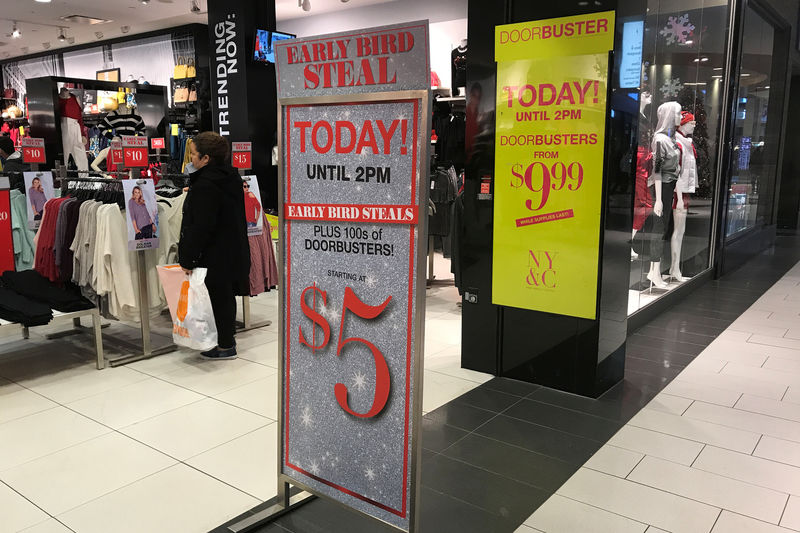 © Reuters. A woman shops inside a store at Roosevelt Field shopping mall in Garden City, New York
© Reuters. A woman shops inside a store at Roosevelt Field shopping mall in Garden City, New YorkBy Lucia Mutikani
WASHINGTON (Reuters) – U.S. consumer spending accelerated in November and shipments of key capital goods orders increased for the 10th straight month, data showed on Friday, the latest signs of strong momentum in the economy as the year winds down.
But the bullish growth picture was dimmed somewhat as the figures also showed household savings dropped last month to the lowest level in more than nine years. Low savings could hurt consumer spending, though economists are optimistic wage growth will pick up in the new year.
Economists see a modest lift to consumer spending from a $1.5 trillion tax cut package approved by the Republican-controlled U.S. Congress this week, in the largest overhaul of the U.S. tax code in 30 years.
“Consumers are still out there spending, but their purchases are being supplemented by low energy costs, credit and a reduction in savings rather than organic income growth,” said Lindsey Piegza, chief economist at Stifel Fixed Income in Chicago. “Without sustained improvement in wages, consumers will struggle to maintain even today’s moderate pace of consumption.”
The Commerce Department said consumer spending, which accounts for more than two-thirds of U.S. economic activity, rose 0.6 percent last month after gaining 0.2 percent in October. Spending last month was buoyed by an increase in demand for motor vehicles, recreational goods and utilities.
When adjusted for inflation, consumer spending increased 0.4 percent in November from unchanged in the prior month. Personal income rose 0.3 percent last month, with wages increasing 0.4 percent.
As a result, households dipped into their savings, which fell to $426.2 billion – the lowest level since August 2008 and down from $466.9 billion in October. The saving rate dropped to a 10-year low of 2.9 percent from 3.2 percent in October.
In addition to savings, consumer spending is being driven by record household wealth, thanks to a booming stock market and rising home prices.
With the U.S. economy near full employment, economists argue that the tax cuts will only provide a modest boost to growth. President Donald Trump signed the tax legislation into law on Friday. It slashes the corporate income tax rate to 21 percent from 35 percent and offers tax cuts for individuals.
The Trump administration argues that the tax cuts will boost both business and consumer spending. But the individual income tax cuts are skewed toward higher-income households, which economists say have a low propensity to consume.
Economists also believe companies will use much of the windfall on stock buybacks and debt reduction.
The dollar was trading slightly higher against a basket of currencies while U.S. Treasury yields rose modestly. Stocks on Wall Street slipped. [MKTS/GLOB]
INFLATION TAME
Despite the increase in spending, monthly inflation remained benign in November. The Federal Reserve’s preferred inflation measure, the personal consumption expenditures (PCE) price index excluding volatile food and energy prices, rose 0.1 percent in November after gaining 0.2 percent in October.
The so-called core PCE price index increased 1.5 percent in the 12 months through November, picking up from 1.4 percent in October. It has undershot the Fed’s 2 percent target since mid-2012 and its progress could determine the pace at which the U.S. central bank raises interest rates next year.
The Fed increased borrowing costs three times this year and has forecast three rate hikes in 2018.
“There is little doubt that structural shifts, including increased global competition, the growth in online retailing and new technologies that enable consumers to find the best price instantly and at little cost, are playing a role in holding down prices,” said Mark Vitner, a senior economist at Wells Fargo (NYSE:) Securities in Charlotte, North Carolina.
In a second report on Friday, the Commerce Department said shipments of non-defense capital goods orders excluding aircraft – a closely watched proxy for business spending – rose 0.3 percent after surging 1.3 percent in October.
Core capital goods shipments are used to calculate equipment spending in the government’s gross domestic product measurement. They have risen every month since February, the longest stretch since the series started in 1992.
The increase in core capital goods shipments over the last two months suggested a strong pace of increase in business spending on equipment in the fourth quarter.
Business investment in equipment rose at its fastest pace in three years in the third quarter, but the momentum could be slowing. Core capital goods orders slipped 0.1 percent last month after rising 0.8 percent in October.
“Real equipment spending has been on a very strong run in recent quarters, but the recent cooling in the orders data signals that there could be some softening to come,” said Daniel Silver, an economist at JPMorgan (NYSE:) in New York.
In a third report, the Commerce Department said new home sales jumped 17.5 percent to a seasonally adjusted annual rate of 733,000 units last month. That was the highest level since July 2007. New home sales surged 26.6 percent from a year ago.
Source: Investing.com




























